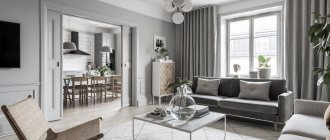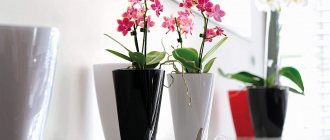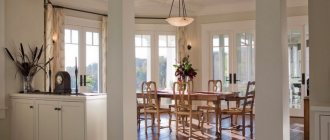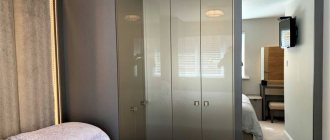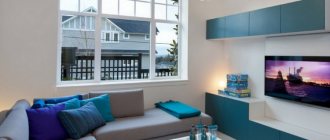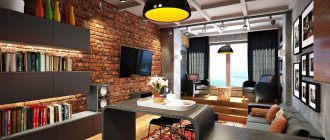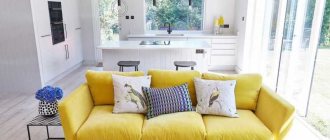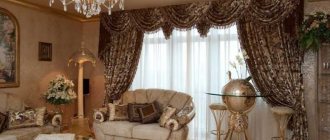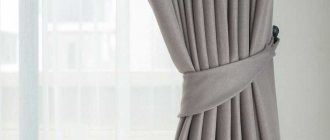What are moldings and what are they like?
Molding is a decorative strip of convex or concave shape. It is used for decoration, harmonization of interiors, visual correction of room defects. Moldings can be narrow - a couple of centimeters wide, and wide - up to 20 cm. They are used for interior and exterior decoration, and can be rigid or flexible. They come with a longitudinal relief (most often), with floral or geometric patterns.
Depending on the installation location, moldings can be ceiling, wall, or corner. Corner ones are usually placed at the junction of the wall and ceiling. Moldings are made from:
- Foam plastic. The cheapest. They have a slightly loose surface, so they are only suitable for puttying and painting. Attached to a flat wall using glue.
Moldings in the living room interior are a very common type of decor. - Polyurethane. More expensive, dense, with a smooth surface. They also stick to walls and ceilings.
- Plastic. Smooth with a shiny surface. They wash well, have a long service life, but are not combined with all materials and are not suitable for all interiors.
- Plaster. Heavier ones are made by casting. Massive elements are attached with nails or self-tapping screws, thinner ones can be glued with a special adhesive composition.
- Wood. Wooden moldings are attached to finishing nails or regular nails without heads. Gluing with wood glue is possible. Fits well into classic, Scandinavian, Russian interiors. All those in which wood trim or decorative items are present in one form or another.
Only a small part of the options with patterns - Metal. They are very durable, but metal moldings can only be used in interiors of a certain type - minimalism, hi-tech, loft.
- Polymer flexible. Polymer flexible moldings are used to decorate columns and rounded walls. They are attached with glue.
Plaster moldings appeared in ancient times. They became the model by which decorative strips for interior decoration were created from more modern and cheaper materials - foam plastic and polyurethane.
Types of decorative moldings
Plaster moldings
Moldings are made from different materials.
It could be:
- gypsum;
- Styrofoam;
- polyurethane;
- plastic;
- marble;
- tree.
Plaster
good because they do not change color over time and are easy to
restore.
Foam and polyurethane
moldings are resistant to
temperature
and high
humidity.
For this reason, these moldings are often used in
the kitchen
and
bathroom
.
The only disadvantage of moldings from can be called insufficient
strength, they are subject to mechanical damage.
But they are inexpensive
and easy to install.
Moldings - strips
Depending on the purpose, moldings of various shapes are produced,
including:
- planks;
- panels;
- baseboards;
- cornices;
- framework.
Note:
Flexible moldings are used for decorative finishing of columns, arches and creation of complex geometric shapes. These moldings are made from polyurethane mixed with rubber.
Where can they be used?
Moldings in the interior are used in the following cases:
- To harmonize the interior. Smooth empty walls and flow are not always attractive. The use of moldings allows you to make the interior more harmonious.
- To separate colors, materials, textures on walls.
In classic interiors, molding is a tradition - For masking cables, communication lines, etc.
- For decorating joints of slabs and wallpaper.
- Zoning of premises.
- Design of doorways.
- Decoration of paintings, mirrors, wall-mounted TVs, etc.
The main function that moldings perform in the interior is decoration and decoration. At the junction of materials with different thicknesses, textures, and colors, this method of decoration allows you to turn an unaesthetic transition into a decorative element. The method is easy to install, most of it has a low cost.
What are wall moldings made of?
One type of classification of moldings involves the raw materials used in production. Both light and rather heavy materials are used here. How certain models look in different interiors can be judged by photos of moldings on the walls, and the advantages and disadvantages of all materials are shown by the data provided in the table.
| Material used | Advantages | Flaws |
| foam moldings | low price; ease; easy installation | used for decorating perfectly smooth surfaces; high level of fire hazard; toxicity; easily damaged |
| wood planks | environmental friendliness; possibility of painting; ease of cleaning; durability; strength | weightiness; complexity of installation with additional fastening; the need for treatment with special means to protect against pests |
| gypsum products | the ability to choose textures and patterns; strength; high aesthetic qualities; able to highlight different styles | large mass; high price; complexity of installation; do not fit into the decor of a small apartment |
| polyurethane moldings for walls | small weight; durability; ease of installation; flexible surface that allows you to decorate uneven surfaces with curves; affordable price; wide selection of models | low environmental safety |
| polystyrene | moisture resistance; possibility of painting; ease; low price | low elasticity; poor resistance to damage |
| metal moldings for walls | strength; durability; originality | inflexible; fits only into modern styles |
| plastic moldings | water resistance; wide choice of colors and shapes | it is impossible to apply paint; toxicity; low strength |
Wide range of applications for polyurethane moldings
Thanks to modern technologies, such an easy-to-use material as polyurethane has been invented. It has become an excellent analogue of traditional plaster, with which you can easily recreate classic lines in the design of different interiors.
Flexible polyurethane moldings are of particular value. Rubber is used in their production, which gives the product the necessary qualities. This is an excellent solution for decorating walls with radius and curved surfaces: such a plank can be easily bent in any direction and fixed in the desired position.
Polyurethane moldings are the most versatile and practical
Polyurethane moldings will also help hide minor defects. They are used in decorating arches, columns, curved walls and ceilings with cornices. Installing moldings between the walls will eliminate unevenness. This also applies to doorways and mirrors.
Most often, polyurethane decorative elements are used in interior design in a classic style. At the same time, a variety of plank options and design approaches allow them to be successfully used in other stylistic directions. When decorating rooms, such products will ideally fit into different places and surfaces.
For interiors in a classic style, polyurethane moldings are most suitable
Application of polyurethane molding
Due to their flexibility, polyurethane moldings can be used in a wide variety of locations. When decorating ceilings, you can use them to create entire compositions. This does not require the help of a specialist. This option is especially relevant if gypsum stucco is unaffordable and you are bored with a flat ceiling. One of the areas of successful use of polyurethane molding is as a ceiling plinth.
The use of polyurethane strips will help create various patterns, ornaments on the ceiling, and zone the room. For this purpose, it is enough to apply markings and, using special glue for polyurethane moldings, attach the parts along the contour.
On walls, polyurethane molding is used in a number of options:
- in the design of doorways;
- in a combination of a number of elements, decorating the mirror frame, door and trim in the same design;
- as a way to create a false window on a large wall by framing photo wallpaper covered with plexiglass.
Polyurethane moldings on the walls can be colored or painted
Polyurethane parts will be an excellent solution for creating decor on furniture. For example, you can give new life to an old cabinet by framing it with moldings and painting it with silver or gold leaf. With their help, you can make frames for pictures, mirrors and arches - this is another successful option for using polyurethane moldings for wallpaper.
A wide selection of products is provided by a variety of patterns and color combinations. Moldings for wallpaper on the wall look especially impressive in places where different types of wallpaper are differentiated.
At the intersection of different materials
If tiles or wall panels are laid only on part of the wall, the transition from tiles/plastic to a flat wall does not look very presentable. In order to make this transition more attractive, they use special border tiles, but they are too expensive - much more expensive than regular ones. No less interestingly, you can design this joint using molding. The decorative strip is mounted so that it covers the joint.
If the tiles do not lie up to the ceiling, the transition can be made using molding
The width and thickness are selected for the specific interior and the thickness of the materials being joined. Since we are usually talking about a bathroom, toilet or kitchen, it is more advisable to use materials that are easy to clean and are not afraid of high humidity. The optimal choice for tile joints is polyurethane. It can then be painted the same color as the wall or tile.
The transition from one material to another is best accomplished using molding
If you are decorating the transition between plastic panels and a painted/bleached wall, you can use a plastic plinth. Wooden panels or MDF panels are best joined to walls using wooden moldings.
The same technique works very well when you have to combine two colors or two textures. Moldings are used to separate and harmonize joints. This can be an accent wall, which is very fashionable now.
You can separate material of a different color using moldings
But an accent wall doesn't have to be a different color or pattern from start to finish. It is for such a case - if a canvas or material of a different color occupies only part of the wall - that moldings come in handy. They give a finished look to this finishing element.
Moldings in different interior styles
Moldings are an excellent detail for the design of rooms in a variety of styles. The main thing is to carefully select a specific version of decorative elements and correctly complement the interior with them.
Classic
Classics are most often chosen by owners of old apartments with arched vaults and high ceilings. The furniture used in room decoration consists mainly of natural materials. It can have different configurations; moldings must be selected according to the same style. The best design solution is to choose flexible panels for walls, arched windows and doors.
Flexible panels for walls, arched windows and doors in a classic style
Baroque
Relief plant images that create a special mood are moldings in the Baroque style. They are most often decorated in light shades, but they can be decorated in any tone. White or golden stucco is used as an additional decoration. Special panels of different sizes are formed on the wall surfaces, which are then painted or covered with wallpaper. Moldings in this interior style play the role of framing elements that support the overall style of the room.
Moldings for the Baroque style
“Baroque” is used in the design of living rooms, dining rooms and bedrooms. It is often chosen as an interior style when designing private houses. The decoration should also match the furniture, you can also add a decorative socket for the chandelier, which should be located in the middle of the ceiling. In this case, the moldings should be straight; you can select parts with different images and shapes.
Scandinavian style
Modern pieces of furniture, strict reliefs and lines, lots of pillows, soft bedspreads and beautiful floor carpets are signs of decorating rooms in this style. Moldings are needed here in order to emphasize the neat lines of the decoration; they frame arches, windows, floors and ceilings
Wall moldings are suitable as additional design elements that focus attention on smooth walls. The planks are painted in shades that are close to the design colors of the entire room
Scandinavian version of moldings as elements that focus attention on smooth walls
English style
In this style, clearly defined reliefs are most often used. Moldings can be installed anywhere on the wall or on any piece of furniture. As for the ceiling, you can frame it with skirting moldings or fix corners with clear shapes in the corners. The English style is not complete without a fireplace - to decorate it you will definitely need moldings. You can decorate a fireplace with a portal constructed by any type of molding with a standard relief.
English style with moldings
Provence
Popular, cozy and relaxing design style. You should choose simple panels with simple reliefs, without three-dimensional patterns. It is necessary to paint the moldings in colors that will be in harmony with the main tone of the room design. A successful design solution is the use of moldings of different widths and shapes.
Moldings in the Provence style with simple panels and simple reliefs, without three-dimensional patterns
Planks are used in the design of floors and ceilings, less often - for the main parts of walls. You can divide the surface into several parts so that boundaries appear - the upper and lower, “panel” sides. Often in rooms in the Provence style you can see doors and windows and mirrors framed with moldings. At the same time, excessive “pretentiousness” is not welcome.
Ceiling moldings
The ceiling is often decorated with moldings. A large empty square just begs to be decorated with something. Typically, corner molding is installed at the junction of the wall and ceiling. It can be thin and simple - with a simple relief, or it can be wide, patterned, like stucco. Moreover, this type of decoration is good not only for classic interiors. It fits into the loft and other modern trends, with the exception of minimalism, perhaps.
Modern style also goes well with moldings
In addition, several decorative fragments can be located on the ceiling. For example, several moldings of different widths, but with a similar decor and profile. They can be placed at a distance from each other. Often, decorative fragments in the form of curls, corners curved in the other direction, half-arcs and other similar decorations are used in the corners. They also put decorative ceiling rosettes under the central chandelier in classical interiors.
This type of ceiling moldings is suitable for almost any interior.
If desired, decorative strips can be highlighted in color
This option is good for classic interiors
A way to make a ceiling beautiful
Another of the variations
If stretch or suspended ceilings are made, the transition is also finished using moldings
Options for decorating the ceiling with moldings
Moldings in the interior: on the ceiling
One of the simplest options for decorating a wall/ceiling joint using corner molding made of polyurethane
Small decorative element in the corner
You can join several decorative strips or place them at a certain distance
The ceiling doesn't always have to be white
But not only in the corner or near it can ceiling moldings be mounted. With their help you can create a unique ornament on the ceiling. Geometrically correct figures are created using polyurethane or gypsum planks. Using flexible molding you can create smooth lines.
In a long and narrow room, this technique helps to visually make it wider
Classic design with geometric pattern
If you use flexible moldings, you can make circles, arcs, smooth lines
To highlight the central part of the ceiling
Again, flexible molding on the ceiling - smooth transitions from one diamond to another, create an interesting effect
Dividing the ceiling into squares with molding is a classic decoration technique
And no one said that decorative strips should match the ceiling...
There is another technique - a coffered ceiling. This technique is usually used if you need to hide beams or some kind of flaw in the ceiling. In this case, moldings are also often used for decoration.
A coffered ceiling can hide beams, pipes and other unsightly elements
Recently, in most cases, polyurethane moldings are used in the interior. They are durable, easy to install, and not too expensive. All this makes them very popular.
Basic techniques for decorating walls with moldings
Imitation of panels and columns
Imitation of columns in an apartment
Moldings are great for more than just decoration
interior, but also to visually
expand
the space.
Since it is known that vertical
elements visually increase the height of the ceilings, then to create this effect you can use various types of panels imitating
columns,
for example.
Or connect the ceiling space
and wall space using
skirting boards
of the same color as the ceiling.
Separating different materials
Molding elements
division is made using moldings
in decorating walls with different materials or one, but different in color and texture.
For example, when companion wallpaper
(read how to hang two types of wallpaper).
The places of their horizontal joints
are decorated with molding panels, which are then painted in a suitable
color.
Creating rhythmic sections
Creating sections using wall moldings
Moldings are also used to divide space into sections.
This technique is well suited for a one-room apartment or studio apartment,
in which there is a need to divide the space into zones.
Additional line of ceiling moldings
Application of moldings on the ceiling
This decorative technique can be used in rooms with high
ceilings.
Along the perimeter of the room, just below the ceiling
baguette, there is a
thinner
molding.
The strip formed by these decorative elements can be covered with the same wallpaper,
the same as the rest of the wall surface, or contrasting.
Framing photographs and decorative elements
Paintings or photos are also framed with moldings
A very popular way to use moldings in the interior is to frame
photographs, paintings,
mirrors,
and other decorative elements.
There are special frames
which are glued to the wall.
They can be painted in any color, and the shape can be chosen to suit the style
of the interior as a whole.
Important:
Before attaching the moldings, it is necessary to make precise calculations and markings, and if a complex composition is planned, apply the entire design to the wall.
To ensure that
no problems arise gluing
- sand its surface, and this will contribute to better adhesion of materials;
- choose the right glue.
Everything will depend on what material the moldings are made of.
For lightweight foam plastic or PVA is suitable.
Moldings made of
polyurethane
are glued to a special mounting adhesive or
gypsum
stucco molding must be attached either to polyurethane glue or to a special gypsum solution.
For wooden
planks, fastening with nails is suitable;
- You need to mark out
a place for installing the moldings, and then carefully glue them. The glue dries in about 5 hours;
- after drying excess
glue is removed and the seams are carefully puttied;
- when everything is completely dry (this will take about 12 hours), you can start painting the moldings and
The question is often asked on Internet forums: “How to glue moldings to wallpaper
?.
In principle, light
moldings can be glued to wallpaper, but
it is not advisable.
Firstly, this is impractical, and secondly, not everyone can cope with such
jewelry
work, because it is necessary to accurately control
the amount
of glue so that there is no excess, and also carefully coat the seams.
Yes, and there will be difficulties with painting
moldings glued to wallpaper.
to do everything neatly
without staining the wallpaper.
As we see, the area
The applications of moldings are very wide.
This is an interesting and unusual decorative element that
performs several functions in the interior.
Moldings decorate
a room, expand it visually,
divide it
into zones, and hide surface imperfections.
Moreover varieties
of moldings that everyone can choose the
ones that are suitable
in shape and size, quality and
price.
How to glue a ceiling cornice, watch the video:
Creating a modern, stylish interior design does not always require significant financial investments. There are many design ideas that, with a minimum investment, allow you to decorate a room beautifully and stylishly. Such ideas include creating panels from wallpaper.
In this article we will introduce you to popular options for this decorative element, and also show photo options.
To decorate a wall with such a decorative element, it is not necessary to purchase expensive wallpaper. The remains of the material that was used during the repair process are quite suitable. Moreover, the patchwork technology used in this case involves the use of pieces, segments and shreds of a wide variety of materials.
This is an interesting solution that allows you to adjust the visual perception of the room. If mirror elements are chosen as the main material, the room will seem more spacious. By making decor from contrasting wallpaper, any room can be made more comfortable. Today modular panels are very popular. This is a new type of fresco, which is made in the traditional way by gluing pieces of canvas onto a textured base. The process of creating a panel of wallpaper on the wall with your own hands is simple but creative. To get a beautiful result, you need to show imagination and artistic thinking.
A great option is to place decorative decorations in the nursery, living room, bedroom, or kitchen. Designers recommend using floral motifs, images of animals, birds, and fish. To decorate a children's room, you can think of a small scene from a fairy tale depicting the main characters.
Moldings on the walls
Wall moldings are not just strips. Frames are made from these elements, which can simply limit part of the space in which a mirror or picture will hang. This selection helps to more clearly organize the space and highlight the subject.
Pictures framed from moldings
Frames made from moldings can also be filled with other finishing material. Previously, tapestries, brocade and other expensive fabrics were inserted into such frames. Today, they are increasingly using a different type of decorative putty, wallpaper, or simply a different shade of paint.
Inside the molding frame is a different color
Another common technique is the design of doorways. In addition to the standard frame of the opening, there is also a frame above the door. This space usually remains empty and is not used in any way. To ensure that there is no imbalance during complex decoration, molding is also glued here.
Slats over the door
Using wall moldings, you can visually make the ceilings higher. To do this, strips are installed at a certain interval. You can use them not only to make frames. These are decorative strips and are not too difficult to create patterns with.
Molding patterns on walls
All these decoration techniques require a large space, otherwise the room turns out to be too “overloaded”. In small rooms, if they are used at all, it is usually only planks at the junction of the wall and ceiling, and maybe a couple of thin strips to separate different textures or colors. Most often you can see moldings in the interior of the living room - these rooms are usually the most spacious. Moldings look good in bedrooms, but not in small ones, but at least in medium ones.
Rules for placing panels in the interior
Any panel, including modular ones, must be placed correctly by choosing the appropriate location.
What to consider:
- The product must be placed on a wall free from decorative elements. It should “live” on its own, not be loaded with additional attributes.
- If the design is mirrored, you need to place it on the wall so that the light falls on it and will be reflected. Thanks to this design move, the room will become visually wider and more spacious.
- If the panel is designed like a painting, then you can use pieces of photo wallpaper or vinyl canvases. Such a product will delight the eye with its uniqueness.
There are modern panels, such as LED ones. They look very original and can decorate any room, such as a children's room or even nightclubs.
When making panels from canvases, it is necessary to take into account the size of the surface being processed and light transmission. Taking into account all these parameters, you can achieve the desired result - get an original wall design.
To highlight the sleeping area, it is possible to decorate the wall with a panel made from pieces of ordinary wallpaper. The most important thing is that it should not deviate from the general concept and should not violate the color schemes of the entire room as a whole. Typically, panels in bedrooms are placed at the head of the bed.
It should be done in calm shades, since this room is intended for relaxation. Also, do not forget that the decoration on the wall should be in lighter colors than the main wallpaper.
A room for children should be bright, dynamic, uplifting the child’s mood, and an interesting decorative solution would be a decorative panel. It can be made from colored clay (polymer), stone, wood, papier-mâché and other materials. An important condition is that it should not cause anxious feelings or fear in the child.
The work can be done in the form of a fairy-tale ship, a magical tree or a beautiful castle and much more. Of course, a decorative panel can also be made from wallpaper; the remaining photo wallpaper can be used as a basis. And if the child himself takes part in creating such a panel, the result of the work will exceed all expectations.
Moldings in the interior: photos, ideas
When decorating rooms with moldings, it is necessary to take into account not only the geometry of the room, but also the design style of the furniture. Decorative strips should have common features with the design of other interior items. Then the design will be consistent and harmonious.
You can insert beautiful wallpaper into molding frames
Wall moldings can be painted to match the walls. In this case, the moldings are not too noticeable, but the interior looks more harmonious
With the right approach, and in a modern style, moldings, and even patterned elements, are not superfluous
If the ceiling were just white, there would be obvious disharmony - too overloaded walls, and an empty ceiling
In a long and narrow hallway, frames visually expand the space
So that the wall is not empty
It's hard to think of another way to decorate
Wall moldings in the form of frames
If you need non-standard decorations, use moldings
The style of moldings should be consistent with the style of furniture design
Doors and wall decorations in one format
Modern classic
Moldings in the living room interior
There doesn't always have to be a lot of them
For spacious and bright rooms
In bedrooms, you should be careful with moldings
What are cornice moldings
Structurally, this is part of the ceiling cladding used to design the transition of the ceiling surface to the wall plane. It is no secret that even after the most thorough plastering and puttying, the upper edge of the wall surface does not always turn out smooth and flat.
Using ceiling molding provides a couple of significant bonuses:
- It is possible to hide the curvilinearity of some part of the ceiling decoration, it is not so striking, and the appearance is more civilized;
- Wiring or even a light cord can be laid in the closed part of the space under the ceiling cornice. Illuminated molding today is considered one of the most modern and interesting design options for the ceiling surface;
- Give the ceiling a more advanced design and improved appearance. A small plastic or wooden edging turns the dull, angular style of the wall-ceiling transition line into a rather pretty and eye-pleasing decorative detail.
Formally, molding is just a decorative overlay on the horizontal line of transition of the ceiling surface to the plane of the wall. But it is the use of soft polymer that allows you to create the impression of ideal space geometry.
The patterns and relief of the molding are selected depending on the ceiling cladding scheme and the interior of the room
For your information! You can often come across the opinion that finishing the ceiling surface with moldings is no longer modern and looks quite archaic. You should not trust the opinion of home-grown “experts” until you have the opportunity to evaluate the style and design with your own eyes.
It is clear that in modern ceiling design, foam plastic and, especially, gypsum stucco are used to a limited extent. It would be inappropriate to try to complement a stylish ceiling made of modern materials, assembled using the latest technologies, with foam or plaster candles, curls, heads, which were actively used in the design of the first half of the last century. Designers use stylized ceiling moldings as cornices in the spirit of a bygone era. It turns out quite beautiful and aesthetically pleasing.
Ceiling molding can be multi-tiered or a modest border in one tier
This is the main advantage of modern ceiling cornices and moldings. You can always try several options for decorative ceiling borders before choosing the option that best suits plasterboard or stretch ceilings.
